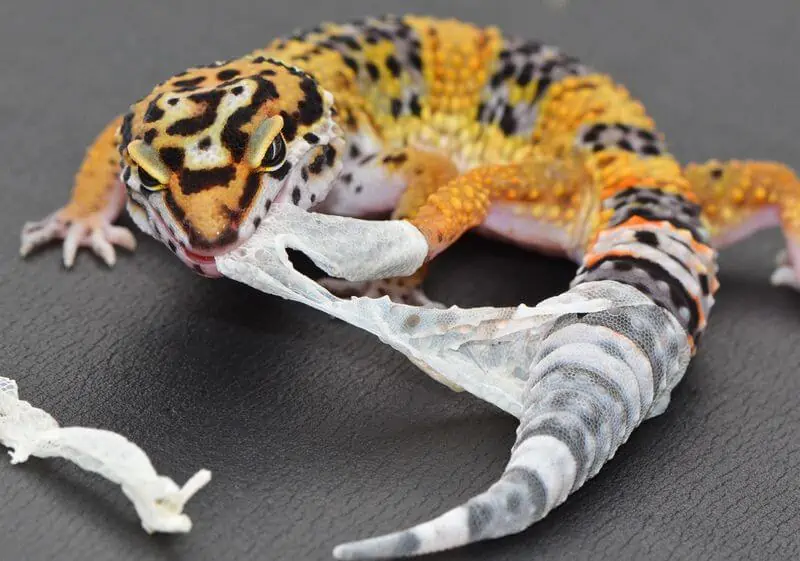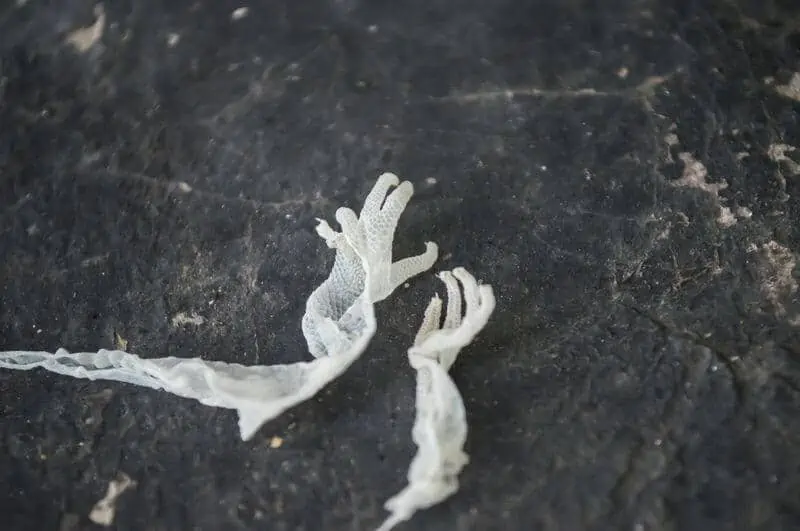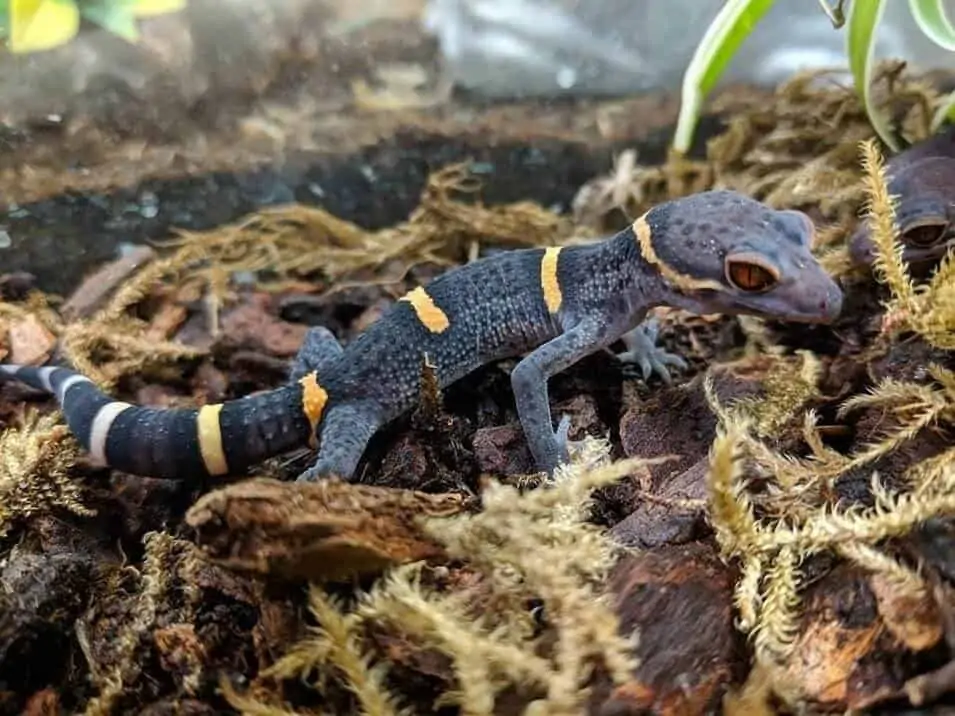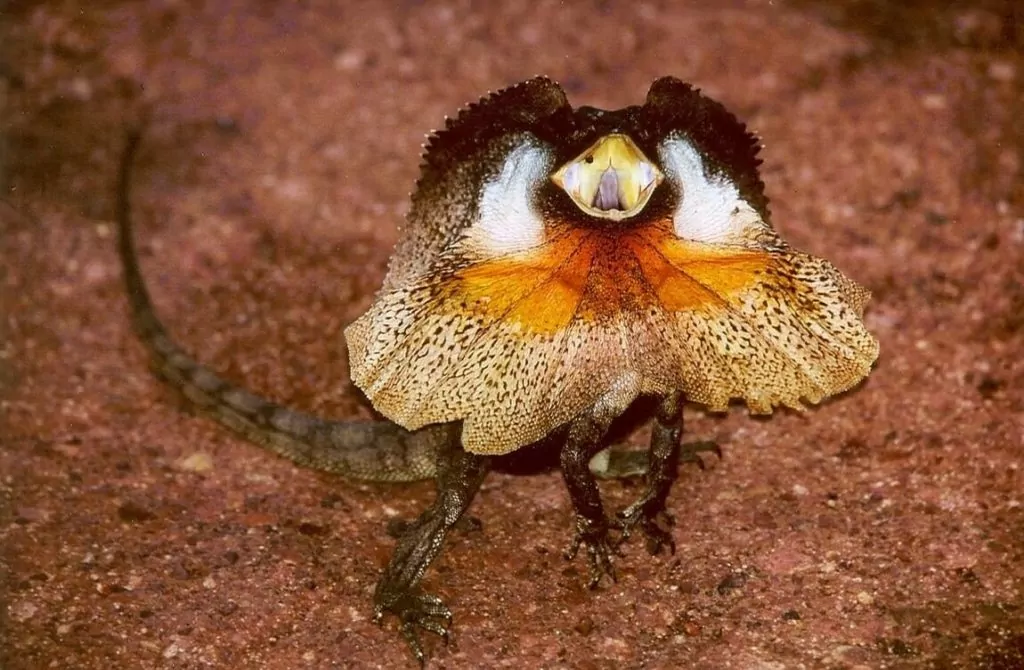Understanding the leopard shedding process is important if you own one of these lizards. While it might seem pretty straightforward, there are certain situations where things won’t go according to plan.
This guide will teach you how often leopard geckos shed, what the process looks like, and how you can help them if they need it.
Table of Contents
The Purpose Of Leopard Gecko Shedding
Shedding is a unique biological process that many animals go through. However, it’s most noticeable in reptiles like the leopard gecko. Mammals shed continuously, removing small bits of skin regularly. But leopard geckos shed their entire epidermis in one piece, making the process look far more dramatic!
When leopard geckos shed, they’re removing the epidermis (the upper layer of skin). Despite how it looks, your gecko isn’t removing an ultra-thick layer.
This process serves many purposes.

One of the main reasons is to make room for new skin. Reptiles have impressive regenerative abilities, and it’s not exclusive to growing a new tail as many species do. Further layers of skin continue to develop, and shedding is a way to make room for it.
Shedding also helps to heal superficial injuries. Despite making your habitat as safe as possible, your gecko can experience minor cuts and abrasions. Shedding cycles heal those old wounds, making your lizard as good as new!
Other reasons why leopard geckos shed are to develop their mature coloration and to help absorb nutrients. The process replenishes the skin cells, paving the way for vibrant colors and patterns to show through.
Expert Tip: In the wild, these reptiles will also shed to remove external parasites like ticks and mites. The epidermis acts as a microscopic protector to keep the lizard healthy. But like an old pair of gloves, geckos have to swap out the old skin to maintain the level of protection they need.
In captivity, leopard geckos usually don’t have to worry about parasites. But these lizards will continue to shed regardless.
What Does The Process Look Like?
The leopard gecko shedding process is fascinating, and it’s fun to watch if you’ve never observed it before. Contrary to popular belief, it doesn’t happen all of a sudden. It’s a relatively slow process, and you can often catch it in its early stages.
There are many signs to look for whenever a leopard gecko is about to shed. These indicators can vary, but it usually starts with dulling coloration.
The otherwise bright coloration will grow dull, taking on a grayish color. The high-contrast spots will become less noticeable, and that beautiful yellow hue will become less saturated. At this stage, the epidermis is flushing its nutrients. The nutrients are absorbed into the body, giving the lizard the fuel it needs to develop a new layer.
It can look alarming. The gray color will make your leopard gecko look a bit sickly. But don’t worry, it’s perfectly normal.
After the nutrients are fully absorbed into the body, lymph fluid floods the microscopic pocket between the old and new skin. This step helps to separate the layers further. It pushes the old skin away, exacerbating that pale and sickly gray color.
The fluid slowly dries, making your leopard gecko look papery. You’ll notice many new wrinkles as the thin, crepe-like layer gets bone dry. Once it does, the actual shedding begins!
Leopard geckos will remove the old layer of skin by rubbing their bodies against a rough object. That tears the skin and gives the lizard more leeway to remove the epidermis manually. Usually, you’ll see leopard geckos biting and tearing the skin off. They may also continue to drag the body against a rougher surface to get the hard-to-reach areas.
As that layer of dried epidermis sheds off, it’ll reveal bright, vibrant, and healthy skin!
Reasons Why Your Leopard Gecko Isn’t Shedding
Shedding is a normal and healthy biological process for leopard geckos. It’s interesting to observe when you first get them, but it quickly becomes something you expect to see regularly. Some reptile enthusiasts can follow shedding cycles like clockwork!
So when a normal shed doesn’t occur, it can be alarming. But why isn’t your leopard gecko shedding like they usually do? Here are some possible reasons.
Brumation, Ovulation, And Nesting
One of the most common reasons leopard geckos stop shedding is because they’re experiencing an event requiring energy conservation.
Female leopard geckos will not shed when they’re ovulating and developing eggs. Laying eggs takes a lot out of female geckos, and they devote their energy to that process instead of shedding. You may not notice your lizard plumping up, but they know when to start nesting.

Leopard geckos can lay eggs without a mate. They’re infertile and should be removed immediately to prevent molding, but the egg-laying process stops shedding nonetheless.
Brumation is another event that will pause shedding cycles. Brumation is similar to hibernation. Leopard geckos do it when temperatures drop in the winter. Instead of sleeping for several months, they become noticeably inactive.
They sleep longer, eat less, and spend far less time moving. Like mammals that hibernate, these pet lizards will preserve their energy during brumation. That essentially puts shedding cycles on pause until things warm up.
Nutrient Deficiencies
If your leopard gecko isn’t getting the nutrients it needs to stay healthy, it will not shed. They may try to, but you’ll notice many issues. For example, only part of the body will shed, or the resulting new skin layer will be paler than it should be.
This issue is more common among leopard geckos raised by inexperienced reptile enthusiasts. It can be tricky meeting all your lizard’s dietary needs if you don’t understand them.
The best thing you can do is work with a vet to figure out what your leopard gecko requires. A protein-rich diet of gut-loaded insects will usually provide the lizards with everything they need, but Vitamin A and calcium deficiencies will cause significant issues.
If that’s the case, you’ll need to invest in high-quality supplement powders to bridge the gap.
Anxiety
Believe it or not, anxiety can interfere with the leopard gecko shedding process. Shedding already puts these lizards in a vulnerable place. They can’t escape would-be predators, and the reptile is naturally weaker as they remove the epidermis.
Anxiety can and will delay shedding. Your pet doesn’t feel safe enough to do it!
There are many causes of anxiety. Poorly maintained enclosures, a lack of enrichment items, or the absence of hiding boxes often cause trouble. They can also be on the other end of nasty bullying if you keep multiple leopard geckos together.
The only solution here is to resolve the conflict and remove the source of stress. Once your gecko feels relaxed and comfortable, it should start shedding again.
Health Problems
Health issues can prevent leopard geckos from shedding as well. As mentioned earlier, shedding takes its toll on your gecko’s energy supply. If their body is fighting off illness, they don’t have the energy to shed.
Something as simple as a mild infection will delay the process. However, more pressing health issues like metabolic bone disease or major injury will pose a problem, too.
Expert Tip: Interestingly, lost tails will prevent shedding, too. The lizard needs the energy to repair the amputation, so they avoid shedding until it heals.
Improper Enclosure Conditions
Shedding requires a good amount of humidity and comfortable temperatures. When those two environmental factors are off, you may notice shedding delays.
Humidity is the biggest issue for many leopard geckos. Maintaining moisture levels is challenging, but it’s necessary for good health. Invest in precise hygrometers. Then, use your ventilation system and sprayers to ensure things are just right.
Discrete Timing
Sometimes, it’s all a matter of timing! Many leopard gecko owners panic because they haven’t seen their lizard shed in months. However, it very well might have happened without you noticing it!
The vulnerability leopard geckos feel when shedding is very real. Many lizards will try to shed in a moist hide box or under cover at night. It’s a natural instinct to avoid shedding out in the open.
But why don’t you see the shed skin? Most leopard geckos immediately eat it after removal, eliminating all signs of shedding!
How To Help A Leopard Gecko Shed
Many of the issues listed above can delay shedding. But they can also make shedding more difficult. Ideally, leopard geckos will shed their skin in one go, leaving no remaining bits behind.
However, minor issues can result in pieces of the epidermis getting “stuck.” Veterinarians don’t recommend removing the skin yourself, but you can take steps to assist your gecko without intervening in the process. Here are some ways to minimize issues and promote healthy shedding.
1. Maintain A Nutrient-Rich Diet
Providing a high-quality diet is a top priority when it comes to leopard gecko care. What your lizard puts into their body directly impacts its health and well-being. A lackluster diet will do more than make shedding more difficult. It can also lead to debilitating health problems.
Expert Tip: Vitamin A deficiencies are usually the dietary cause of difficult shedding. Feed your gecko plenty of nutrient-rich foods. Some of the lizard’s favorites are crickets, Dubia roaches, mealworms, and superworms.
2. Get Enclosure Conditions Just Right
Earlier, we mentioned that humidity levels could delay shedding. Not enough moisture in the air will make the skin more challenging to remove, and too much humidity often results in small pieces getting stuck on hard-to-reach parts of the body.
Purchase a hygrometer and keep humidity levels at 40 percent. Don’t let the levels drop below 30 percent. There is some wiggle room, but you should always aim for around 40 percent to keep things as comfortable as possible.
Don’t forget about lighting. Lighting does more than maintain the day/night cycle. It also helps provide Vitamin D, ensuring that your gecko can synthesize calcium and stay healthy.
Leopard geckos need real UVB exposure, so make sure to install a lighting rig with UVB bulbs.
3. Provide A Bathing Vessel
When small bits of skin get stuck, it can pose significant health problems. While it’s rare, that skin can tighten around fingers and legs, cutting off blood circulation.
One way to help your leopard gecko shed is to give them a bath. You can install the bath in their enclosure and allow them to bathe independently, or you can take them out and do it yourself!
Fill a small plastic container with lukewarm water. Place your pet in the container. Make sure the water level is only at chin height.
Let your leopard gecko soak for about 10 minutes. This process will soften the dried layer of the epidermis, making it easier to slough off. Vets recommend trying the bath method if your gecko still has bits of skin left after 24 hours of trying to remove it.
4. Create A Shedding Box
Here’s a great alternative that can help your leopard gecko shed. Instead of bathing, create a moisture-rich hide box!
The box must be big enough for the leopard gecko to get in. It also needs a small ventilation hole to allow the moisture you’ll add to evaporate, preventing mold.
Fill the box with moist coconut coir, sphagnum moss, and a shredded paper towel. Those materials should be damp but not soaking wet.
Leopard geckos will climb into the box and often roll around. The materials you add help to scrub the lizard clean. Meanwhile, the moisture softens the epidermis for easy removal.
5. Mist Your Gecko
Another option is to mist your gecko with lukewarm water. Avoid the face and allow the moisture to sit on the skin for up to 30 minutes before patting your pet.
This method works similarly to a bath or a hide box. It’s about softening the skin.
Expert Tip: You may find products called “shedding aids” at your local pet store. You can use those, too. They’re misting products that contain safe oils to soften the skin. You can spray it like a standard mist or use a cotton swab to apply it to your gecko’s skin.
How Often Do Leopard Geckos Shed?
Leopard geckos shed more often than most realize. The continual regeneration of the skin will make the process a common occurrence. However, the exact frequency will depend on your lizard’s age and overall health.
Typically, hatchlings and young juveniles will shed once or twice a month. They are growing quickly, and shedding helps young lizards get bigger and bigger. This rate of shedding usually continues until the gecko is about six weeks old.
From six weeks to maturity, shedding slows down to about once every three weeks.
Adult leopard geckos will only shed every four to eight weeks. You can see your lizard shed as much as 12 times during the year!
There are periods when leopard geckos don’t shed. The process pauses whenever a lizard is nesting or brumating. Shedding is an exhaustive process that takes a considerable amount of energy, so they forgo it during brumation and nesting to stay strong.
How Long Does It Last?
Shedding cycles usually last from one to three days for healthy leopard geckos. The timer technically starts when the skin begins to dull. It takes a bit longer than most realize, but healthy lizards will have no problem taking care of things on their own.
After the epidermis dries and leopard geckos actively work to remove it, the process is typically rapid. Most geckos remove the skin within an hour. However, some may take as many as 24 hours. It all depends on their health and the quality of the shed.
You may notice some behavioral changes during the shedding cycle. Leopard geckos tend to lose their appetite and get a bit sluggish. That’s normal, but it’s wise to keep an eye on your gecko. If they continue to be lethargic and don’t eat after three days, you need to take action and see a vet!
Don’t be surprised if your leopard gecko isn’t their usual jolly self. Many will get irritable and anxious, and they’re known to lash out at owners during this time.
You must remember that shedding is a vulnerable time for leopard geckos. In the wild, it’s when they’re most powerless against would-be predators. Give your gecko some space and allow them to take care of the process.
But if you notice that they’re having a difficult time and taking longer than the three-day norm, don’t hesitate to take action.
Wrapping Up
Now that you know about the leopard gecko shedding process and what to expect, it won’t intimidate or surprise you if things don’t go according to plan. All you need to do is keep an eye on your pet and take action when needed!
If you have any questions about the shedding process that we didn’t cover in the guide above, send them over. We’ll help you as much as we can.


